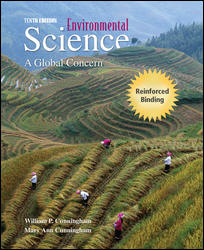Environmental Science, 10th Edition (Cunningham)Feature SummaryWHAT SETS THIS BOOK APART? A positive viewpoint
We wrote this book because we think it’s important for students to realize the difference they can make in their community. We believe a book focused on gloom and decay provides little inspiration to students, and in this time of exciting change, we think such a gloomy view is inaccurate. Many environmental problems remain severe, but there have been many improvements over past decades including cleaner water and cleaner air for most Americans. The Kyoto Protocol, despite its imperfections, is now pushing nations to reduce their climate impacts. The earth’s population exceeds 6 billion people, but birth rates have plummeted as education and health care for women have improved. This book highlights these developments and presents positive steps that individuals can take, while acknowledging the many challenges we face. Case studies that show successful projects, a new chapter on Restoration Ecology, and "What Can You Do?" boxes are some of the features written to give students an applicable sense of direction? A number of other features also set this book apart. An integrated, global perspective
Globalization spotlights the interconnectedness of environmental concerns, as well as economies. To remain competitive in a global economy, it is critical that we understand conditions in other countries and cultures. This book provides case studies and topics from regions around the world, as well as maps and data showing global issues. These examples also show the integration between environmental, social, and economic conditions at home and abroad. A balanced presentation that encourages critical thinking
Environmental science often involves special interests, contradictory data, and conflicting interpretations of data. Throughout the text, one of the most important skills a student can learn is to think analytically and clearly about evidence, weigh the data, consider uncertainty, and skeptically evaluate the sources of information. We give students opportunities to practice critical thinking in brief "Think About It" boxes and in "What Do You Think?" readings. We present balanced evidence, while not suggesting that any opinion is on par with ideas accepted by the community of informed scientists, and we provide the tools for students to discuss and form their own opinions. Emphasis on science
Science is critical for understanding environmental change. We emphasize principals and methods of science through coverage on uncertainty and probability, new graphing exercises, data analysis exercises, and "Exploring Science" readings that show how scientists observe the world and gather data.  | 




